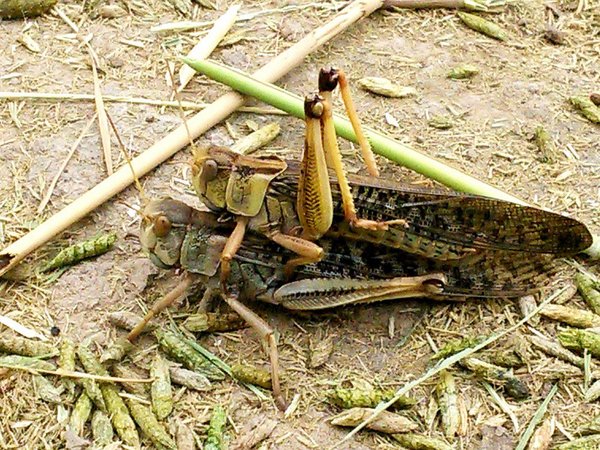 Read this article in French
Read this article in French- Share this article
- Subscribe to our newsletter
Using eco-friendly biopesticides to combat Oriental migratory locusts
Locusta migratoria manilensis, commonly known as the Oriental migratory locust, is one of the most dangerous threats to crop production and food security in South-East Asia and China. Crops at risk include maize, rice and peanuts. Pastures can also be seriously damaged.
While there have been no major outbreaks in recent years in China, there are still significant populations of the locust in the marshlands of the Jilin, Shanxi and Shandong Provinces. They pose a threat to food production and the region’s ecology.
The lead author on the study is Dr Hongmei Li, Senior Scientist at CABI in China. Working with scientists from the National Agro-Tech Extension and Service Centre, Beijing, Zhejiang University and the University of Cordoba, Spain, she suggests that the body heat of the locusts is key to the effectiveness of the biopesticides.
The biopesticides – entomopathogenic fungi (EPF) – have already been widely promoted in an effort to reduce the use of more harmful pesticides in tackling Oriental migratory locusts. However, the scientists point out that EPF tend to work better on insects with lower body temperatures.
Dr Hongmei Li and the scientists argue that the biopesticides should be used on younger locusts at dawn or dusk as they tend to have lower temperatures more suitable for EPF use. This minimises the risk of a locust outbreak.
“Current pest management techniques would benefit from understanding the behavioural rhythms of the target pest and its body temperature, a critical aspect not well studied and potentially limiting the effectiveness of biopesticides under natural conditions,” said Dr Hongmei Li.
The study – published in Frontiers in Physiology – sought to understand the behavioural patterns of different stages of hoppers (younger locusts) and adults of the Oriental migratory locust, as well as the environmental factors that modulated their body temperatures through field observation.
Application of biopesticides should target younger locusts
The scientists carried out intensive field sampling in two of the main breeding regions in China. This included recording the day and night body temperatures of 953 locusts as well as their morphological traits (stage, sex and size) and microhabitat.
The results of the study revealed that locusts, particularly hoppers, preferred the ground as their main sub-habitat. Adults tended to move up in the reed canopy at two peaks – 10am to 11am and 2pm to 3pm. The body temperature of the locusts during the daytime increased with development stage and size, while the opposite pattern occurred at night-time.
According to the researchers, entomopathogenic fungi are more effective if the body temperature of the target pest is neither too high nor too low. The biopesticides should, therefore, be applied primarily on younger locusts – and sprayed in the morning or at dusk, when the locusts have lower body temperatures.
The scientists highlight that the ground truth data that they have identified could in future complement advanced technologies used to tackle crop pests. This includes earth observation and other agricultural applications.
The MARA-CABI Joint Laboratory for Biosafety is a collaborative partnership between the Chinese Ministry of Agriculture and Rural Affairs and the UK-based CABI. It also includes the Institute of Plant Protection at the Chinese Academy of Agricultural Science.
(CABI/wi)
Reference:
You can read the paper in full here:
Li H, Zhu J, Cheng Y, Zhuo F, Liu Y, Huang J, Taylor B, Luke B, Wang M and González-Moreno P (2023), Daily activity patterns and body temperature of the Oriental migratory locust, Locusta migratoria manilensis (Meyen), in natural habitat. Front. Physiol. 14:1110998.DOI: 10.3389/fphys.2023.1110998
More information:
Read more about CABI’s work in development cooperation in Africa





Add a comment
Be the First to Comment